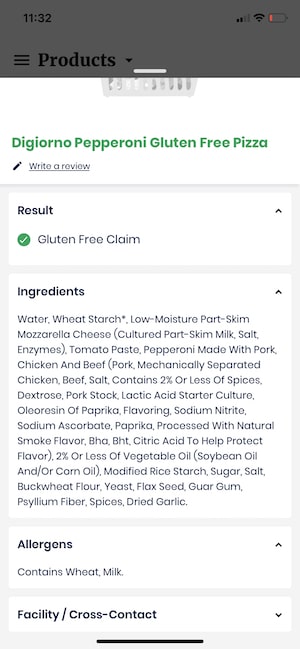Gluten-free and wheat-free might seem like the same diet, but actually, they aren’t. That doesn’t stop people from confusing the two though. This is just one of the many examples of how you might think living gluten-free or wheat-free is straightforward — in many cases, it’s anything but.
From food being labeled gluten-free but also somehow containing wheat starch (we’ll get into that more in a moment). To allergy menus marking wheat in food but not the other gluten-containing grains like barley and rye. It can be confusing to navigate our food system when it’s trying to protect both people with celiac disease and a wheat allergy. The following article looks to shed some light on some common misconceptions about both of these diets, and help you make the best choice for your body.
Wheat Allergy vs. Celiac Disease
Speaking of celiac disease and a wheat allergy, these two different conditions are why gluten-free and wheat-free mean something different.
A wheat allergy is when someone has an IgE immune response to any of the proteins found in wheat. Often it can cause nausea, abdominal pain, itching, swelling of the mouth, and anaphylaxis which can lead to death.
One key difference is that a wheat allergy isn’t always lifelong. Often people can grow out of it, especially children. Whereas celiac disease is lifelong no matter when you were diagnosed.
However, the biggest difference between a wheat allergy and celiac disease is that there is no general tolerable threshold of safety when it comes to a wheat allergy. Meaning people with a wheat allergy can have zero wheat. Whereas people with celiac can tolerate <20ppm of gluten in food.
That’s because celiac disease is a different medical condition from a wheat allergy. Celiac disease is an autoimmune disorder thought to be primarily mediated by IgA. There are over 300 reported symptoms of celiac disease. The defining feature being the small intestinal damage that occurs after eating gluten.
This small intestinal damage from gluten with celiac disease can cause malnutrition, nutrient deficiencies like anemia, infertility, complications with bone health, and more. And over time, if celiac goes untreated, it could lead to deathly complications but nothing as immediate as anaphylaxis with a wheat allergy.
So a wheat allergy means zero wheat and celiac disease means a gluten-free diet with <20ppm of gluten in all foods. This means gluten-free and wheat-free carry very different meanings. It is important to note that people can have both at the same time. This means some people may have to live wheat-free and gluten-free at the same time.
Gluten-Free Vs. Wheat-Free
As discussed above, gluten-free and wheat-free don’t mean the same thing because they are designed for different medical conditions. This also means there are different labeling laws in the USA designed to protect the two conditions.
Regulating the Declaration of Wheat in Food
Before we dive into what gluten-free means, let’s talk about what wheat-free means. Wheat-free means no wheat, period. The 2004 Food Allergen Labeling And Consumer Protection Act (FALCPA) ensures that people with a wheat allergy (or other top 8 food allergies) are safe.
Essentially what the 2004 FALCPA ruling means is that any product with any of the top 8 food allergens (milk, eggs, fish, shellfish, tree nuts, peanuts, wheat, and soybeans) must clearly list them on the food label in the “contains” statement (also known as the allergen statement). So if there is wheat in a product, it must be identified in the allergen statement.
But wheat is only one of the gluten-containing grains people with celiac can’t have. People with celiac also can’t have rye and barley. On top of that, there are some cases of wheat-derived ingredients that are considered gluten-free and celiac-safe but not wheat-free.
Cases like wheat starch, where the gluten has been removed to <20ppm which is considered safe for celiacs but remember, people with a wheat allergy don’t have a generally safe threshold like celiacs do, so it’s not safe for them (more on this in a moment).
Regulating the Term “Gluten-Free” in Food
So this is where telling the difference between gluten-free and wheat-free is important. The 2004 FALCPA ruling for food allergies is helpful for people with celiac, but not entirely. This is why the 2013 FDA definition of “gluten-free” was so impactful.
Because of this FDA ruling, if a company labels a food product as gluten-free they have to ensure the product has <20ppm of gluten (the researched safe threshold for people with celiac). This means wheat derivatives like wheat starch and sometimes glucose is allowed in gluten-free products as long as they test to <20ppm of gluten.
Meaning gluten-free products might not always be safe for people with a wheat allergy. And the contains “wheat” statement on food items might not always mean the product isn’t safe for people with celiac.
Examples of Gluten-Free vs. Wheat-Free Products
Alright, I just tossed a ton of information your way, so let’s talk about gluten-free vs. wheat-free via some real-life labeling examples in the USA.
Let’s start with Digiorno Gluten-Free Pizza, above you can see a scan from our app of the pizza. You can see that not only is it gluten-free but it also contains wheat starch.

Now because products that are gluten-free are safe as long as they contain <20ppm, this means wheat starch is allowed as long as it’s been verified to have <20ppm of gluten in it. Remember, gluten is a protein, and starch is a carbohydrate.
So this would be safe for someone with celiac disease but not for someone with a wheat allergy.
And the next example we’ll use is Irresistibly Smooth Milk Chocolate Lindt Lindor Truffles. You can see that when using the Spoonful app to scan for wheat as an allergen, it says that these truffles are wheat-free. So they’d be safe for someone with a wheat allergy.
However, if you read the ingredients you can see “Barley Malt Powder” listed twice. Barley malt powder is a gluten-containing ingredient and is not considered safe for people with celiac.
So this is an example of a wheat-free product that is not gluten-free.
Basically, Wheat-Free Does Not Mean Gluten-Free (and Vice Versa)
Ultimately, what I hope has been made clear is that wheat-free is not the same as gluten-free. Both diets are designed for different conditions.
That’s why you might see “contains wheat” or “may contain wheat” or “processed in the same facility as wheat” on the label of gluten-free products. It’s also why you might see gluten ingredients like malt extract in wheat-free products.
Moral of the story: always check the food label to make sure food is safe for you. And if you need help, Spoonful is just a tap away.

Thank you
As a person with celiac this has been helpful
Of course! Glad to help!
Thank You! I am celiac and didn’t understand this issue. And I am still trying to understand what I read.
We need more articles like this.
I learned it the hard way when I got an allergic shock from a gluten free pasta. I am from Europe and this gluten free wheat starch is relatively new. I eat gluten free for years never sth happend. I am super allergic to wheat and some other grains but all containing also gluten (while there are some grains with gluten I can eat ) I always thought when I eat gluten free it would be the safest option. As wheat and all the other grains I am allergic to contain naturally gluten I never had the idea that crazy company’s would remove gluten chemically to label it gluten free. So I ate this gluten free pasta in Mexico on vacation and felt safe. Until I couldn’t breathe anymore and lost consciousness. Thanks god my husband immediately knew what’s going on and carried me to the hospital. Dead was close.
Thanks
I recently had an episode of what could be “sudden onset wheat allergy”
This has to be clinically diagnosed but these are some of the symptoms I had:
Itchy palms, fingers and inner lower arms
Some minor discomfort swallowing
Some chest tightness
I have started a gluten free diet and have been free of symptoms but am now conscious of the difference between wheat and gluten free
Many thanks for your article
Brian
See above